Aurantium, Orange peelOrange Peel: Ju Pi, Ju HongDried Orange Fruit: Zhi Ke Immature Orange Fruit: Zhi Shi |

|
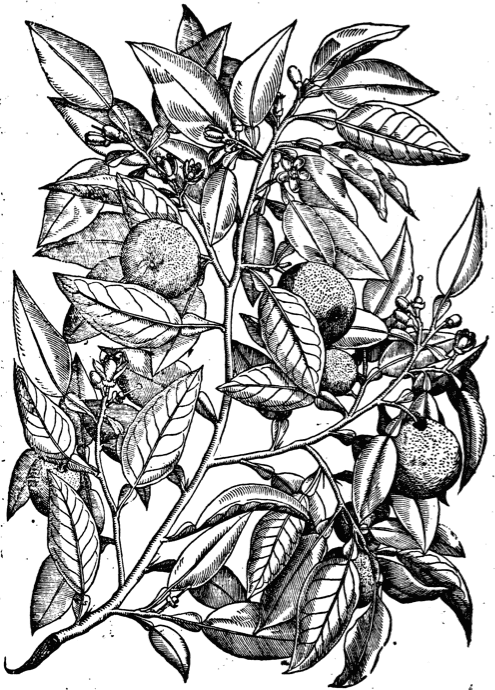
|
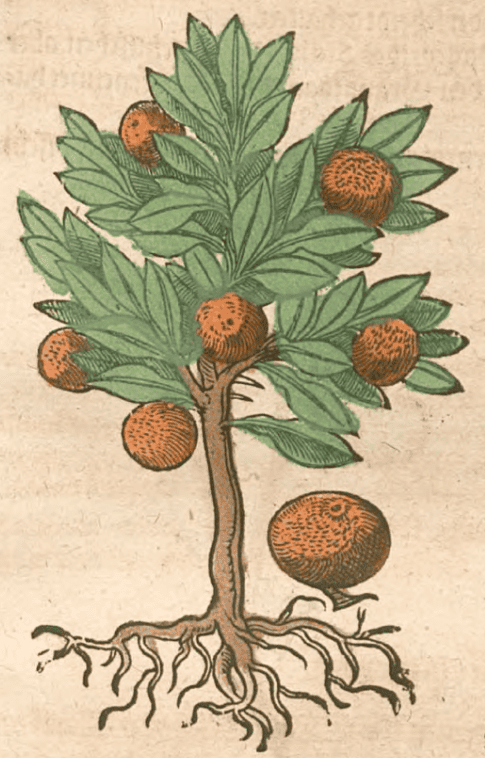
|
|
New Kreuterbuch, Matthiolus, 1563 |
Krauterbuch, Lonitzer, 1578 |
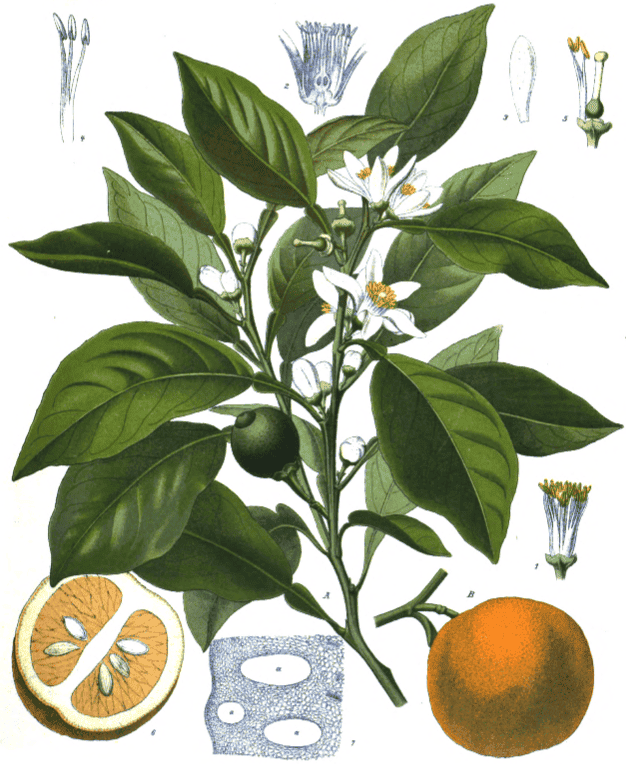 Kohler’s Medizinal Pflanzen, 1887
Kohler’s Medizinal Pflanzen, 1887
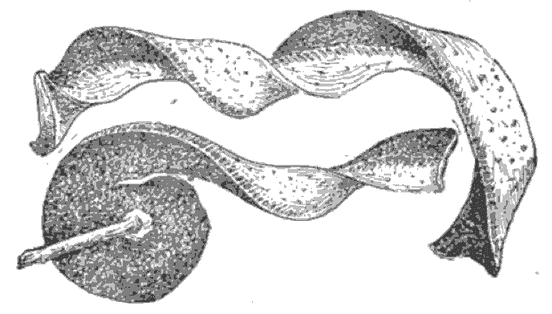
|
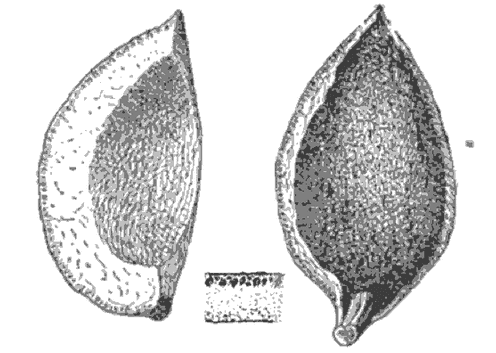
|
Notes on Pharmacognosy, Otto Augustus Wall, 1902
 Members CLICK HERE for the PRO VERSION
Members CLICK HERE for the PRO VERSIONBotanical name:
Citrus spp.
- C. aurantium
- C. wilsonii is also used in TCM.
Sweet and Bitter Orange peels are used in Medicine.
Parts used:
Peel; Dried Fruit (mature and immature); Juice; Flowers; Seed
Temperature & Taste:
Dried peel: Warm, dry. Bitter, aromatic; Fruit: Cool, moist, sweet
Classification:
2H. CARMINATIVES
3D. CORDIALS & CARDIACS. 3L. ANTI-TUSSIVE
4a. CEPHALIC. 4c. CARDIAC. 4e. STOMACHIC
Uses:
ORANGE PEEL (Ju Hong):
1. Warms the Stomach, clears Damp, moves Qi:
-Colic, poor appetite, nausea, vomiting, belching, bloating;
-warms and strengthens a cold or damp Stomach
2. Clears Damp, Promotes Urine
-Edema, fluid retention from Damp
3. Clears Phlegm, Stops Cough:
-as with its Chinese cousin, Tangerine peel, used for Cold-Phlegm Cough and obstruction of Phlegm in the Chest.
4. Warms the Heart, Resists Poison (West):
-protects Heart from Poison
-Heart Yang deficiency
DRIED ORANGE FRUIT (Zhi Ke):
1. Moves the Qi:
-used similarly to Orange peel, but is milder
IMMATURE ORANGE FRUIT (Zhi Shi):
1. Breaks Up Qi, Resolves Stagnation:
-indigestion, abdominal fullness and distention
2. Clears Damp, Resolves Phlegm:
-Cold Phlegm obstructing the Chest
ORANGE BLOSSOM:
1. Moves Qi and Blood, Promotes Menstruation:
-Painful Menstruation
2. Moves the Qi, Calms the Mind:
-nervousness, anxiety, depression
Dose:
Orange Peel, Orange Fruit and Immature Orange Fruit are all used in similar doses.
Peel, Fruit or Immature Fruit in Powder: 1–3 grams
Peel, Fruit or Immature Fruit in Decoction: 3–9 grams
Flowers: 1–2 teaspoonfuls in infusion; 1–2 spoonfuls of the distilled water.
Preparation:
… available in PRO version
Comment:
Orange peel has been used in East and West. TCM is particularly fond of medicines derived from the Citrus, a number of different medicines being supplied by this family, all being carminative medicines used to regulate the flow of Qi.

Main Combinations:
ORANGE PEEL:
1. Warms the Stomach, move Qi, for Abdominal discomfort, nausea, loss of appetite:
i. Orange peel with … available in PRO version
ii. Orange peel with … available in PRO version
iii. Orange peel with … available in PRO version
iv. Orange peel with … available in PRO version
v. Orange peel with … available in PRO version
vi. Orange peel with … available in PRO version
vii. Orange peel with … available in PRO version
2. Carminative: Orange peel, … available in PRO version
3. Spasm and pain of the Stomach or Intestines, combine Orange peel with … available in PRO version
4. Stomach weakness with bloating, discomfort, combine Orange peel with … available in PRO version
5. Jaundice, Unripe Orange (2), … available in PRO version
DRIED ORANGE FRUIT (Zhi Ke):
1. Chest congestion, Orange fruit (Zhi Ke) with … available in PRO version.
2. Itchy skin, Orange fruit (Zhi Ke) with … available in PRO version
IMMATURE ORANGE FRUIT (Zhi Zi)
1. Chest pain from Cold Phelgm and Heart Yang deficiency, Immature Orange fruit (Zhi Shi) with … available in PRO version
2. Abdominal fullness from Phlegm obstruction, Immature Orange fruit (Zhi Shi) with … available in PRO version
3. Food stagnation, Immature Orange fruit (Zhi Shi) with … available in PRO version
4. Cholecystitis, Immature Orange fruit (Zhi Shi) with … available in PRO version
5. Uterine prolapse, Immature Orange fruit (Zhi Shi) with … available in PRO version
ORANGE BLOSSUM:
1. Depression related to menstruation, Orange flower, with … available in PRO version
2. To calm the Mind and Nerves, mild Depression or Anxiety:
i. Orange flower with … available in PRO version
ii. Orange flower with … available in PRO version
iii. Orange flower with … available in PRO version
iv. Orange flower with … available in PRO version
Major Formulas:
Compound Infusion of Orange Peel
Compound Infusion of Gentian
Powder for Epilepsy (Bicker)
Powder for Hysteria
Powder for After-pains (Lemery)
Powder of Plantain Compound
Uterine Powder (Species Hysterica)
Ointment for Hemorrhoids
TCM:
An Shen Zhen Jing Er Shi Pian
Bao He Wan
Chai Hu Shu Gan San
Da Chai Hu Tang
Da Cheng Qi Tang
Ge Xia Zhu Yu Tang
Hui Chun Dan
Ma Zi Ren Wan
Ping Xiao Capsules
Ren Shen Bai Du San
Si Ni San
Wen Dan Tang
Xue Fu Zhu Yu Tang
Cautions:
1. The peel is drying, so it not suitable for Yin deficiency.
2. Caution during Pregnancy. Peel, Dried Fruit and Immature Dry Fruit should all be used cautiously during Pregnancy, especially the Immature Fruit which is strongest.
Main Preparations used:
Water of the Flowers, Juice of the Sour Oranges, Syrup of the Sour Orange Juice, Candied Orange Peel, Conserve of the Flower, Electuary of the Peel, Distilled Oil of the Peel
-
Extra Info
- History
|
‘The orange was unknown to the ancient Greeks and Romans; and its introduction to Europe is due to the Arabs, who, according to Gallesio, appear to have established the tree first in Eastern Africa, Arabia, and Syria, whence it was gradually conveyed to Italy, Sicily, and Spain. In the opinion of the writer just quoted, the bitter orange was certainly known at the commencement of the 10th century to the Arabian physicians, one of whom, Avicenna, employed its juice in medicine. There is strong evidence to show that the orange first cultivated in Europe was the Bitter Orange or Bigarade. The orange tree at Rome, said to have been planted by St. Dominic about A.D. 1200, and which still exists at the monastery of St. Sabina, bears a bitter fruit; and the ancient trees standing in the garden of the Alcazar at Seville are also of this variety. Finally, the oranges of Syria (ab indigenis Orenges nuncupati) described by Jacques de Vitri, Bishop of Aeon (ob. A.D. 1214) were acidi seu pontici saporia. |
The Sweet Orange began to be cultivated about the middle of the 15th century, having been introduced from the East by the Portuguese. It has probably long existed in Southern China, and may have been taken thence to India. In the latter country there are but few districts in which its cultivation is successful, and the Bitter Orange is hardly known at all. The name it has long borne of China or Portugal Orange indicates what has been the usual opinion as to its origin. It probably alludes more exactly to a superior variety brought about 1630 from China to Portugal. One of the first importations of oranges into England occurred in A.D. 1290, in which year a Spanish ship came to Portsmouth, of the cargo of which the queen of Edward I. bought one frail of Seville figs, one of raisins or grapes, one bale of dates, 230 pomegranates, 15 citrons, and 7 oranges (“poma de orenge“). (Pharmacographia, Fluckiger & Hanbury, 1879) |
For a general History of the Citrus family, see Lemon
